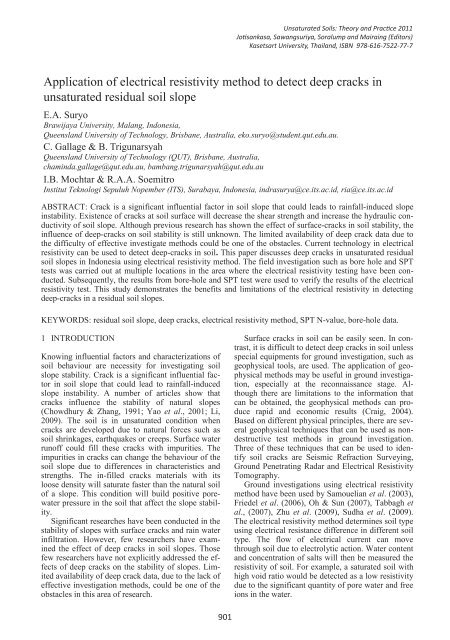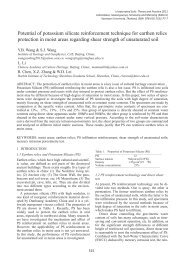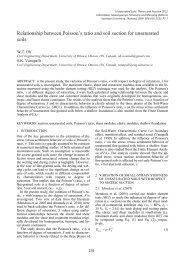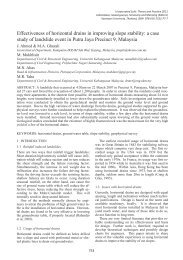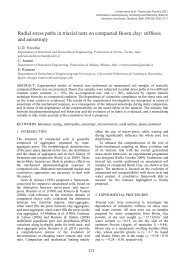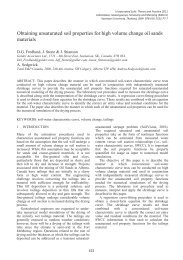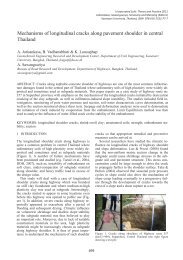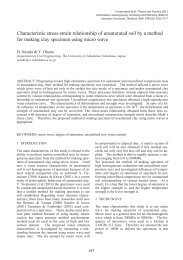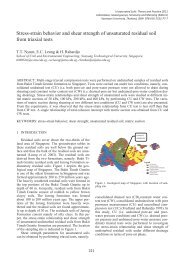Application of electrical resistivity method to detect deep cracks in ...
Application of electrical resistivity method to detect deep cracks in ...
Application of electrical resistivity method to detect deep cracks in ...
Create successful ePaper yourself
Turn your PDF publications into a flip-book with our unique Google optimized e-Paper software.
Unsaturated Soils: Theory and Practice 2011<br />
Jotisankasa, Sawangsuriya, Soralump and Maira<strong>in</strong>g (Edi<strong>to</strong>rs)<br />
Kasetsart University, Thailand, ISBN 978-616-7522-77-7<br />
<strong>Application</strong> <strong>of</strong><strong>electrical</strong> <strong>resistivity</strong> <strong>method</strong> <strong>to</strong> <strong>detect</strong> <strong>deep</strong> <strong>cracks</strong> <strong>in</strong> unsaturated<br />
<strong>Application</strong><br />
residual<br />
<strong>of</strong> <strong>electrical</strong><br />
soil slope<br />
<strong>resistivity</strong> <strong>method</strong> <strong>to</strong> <strong>detect</strong> <strong>deep</strong> <strong>cracks</strong> <strong>in</strong><br />
unsaturated residual soil slope<br />
Eko E.A. Andi Suryo Suryo,<br />
Brawijaya<br />
Brawijaya<br />
University,<br />
University, Malang,<br />
Malang,<br />
Indonesia,<br />
Indonesia<br />
Queensland University <strong>of</strong> Technology, Brisbane, Australia, eko.suryo@student.qut.edu.au.<br />
Queensland University <strong>of</strong> Technology, Brisbane, Australia, eko.suryo@student.qut.edu.au.<br />
Cham<strong>in</strong>da C. Gallage Gallage & B. Trigunarsyah & Bambang Trigunarsyah<br />
Queensland University <strong>of</strong> Technology <strong>of</strong> Technology (QUT), (QUT), Brisbane, Brisbane, Australia, Australia, cham<strong>in</strong>da.gallage@qut.edu.au,<br />
bambang.trigunarsyah@qut.edu.au.<br />
cham<strong>in</strong>da.gallage@qut.edu.au, bambang.trigunarsyah@qut.edu.au<br />
Indrasurya I.B. Mochtar B. & Mochtar R.A.A. & Soemitro Ria Asih Aryani Soemitro<br />
Institut Teknologi Sepuluh Nopember (ITS), Surabaya, Indonesia, <strong>in</strong>drasurya@ce.its.ac.id, ria@ce.its.ac.id<br />
ABSTRACT: Crack is a significant <strong>in</strong>fluential fac<strong>to</strong>r <strong>in</strong> soil slope that could leads <strong>to</strong> ra<strong>in</strong>fall-<strong>in</strong>duced slope<br />
<strong>in</strong>stability. Existence <strong>of</strong> <strong>cracks</strong> at soil surface will decrease the shear strength and <strong>in</strong>crease the hydraulic conductivity<br />
<strong>of</strong> soil slope. Although previous research has shown the effect <strong>of</strong> surface-<strong>cracks</strong> <strong>in</strong> soil stability, the<br />
<strong>in</strong>fluence <strong>of</strong> <strong>deep</strong>-<strong>cracks</strong> on soil stability is still unknown. The limited availability <strong>of</strong> <strong>deep</strong> crack data due <strong>to</strong><br />
the difficulty <strong>of</strong> effective <strong>in</strong>vestigate <strong>method</strong>s could be one <strong>of</strong> the obstacles. Current technology <strong>in</strong> <strong>electrical</strong><br />
<strong>resistivity</strong> can be used <strong>to</strong> <strong>detect</strong> <strong>deep</strong>-<strong>cracks</strong> <strong>in</strong> soil. This paper discusses <strong>deep</strong> <strong>cracks</strong> <strong>in</strong> unsaturated residual<br />
soil slopes <strong>in</strong> Indonesia us<strong>in</strong>g <strong>electrical</strong> <strong>resistivity</strong> <strong>method</strong>. The field <strong>in</strong>vestigation such as bore hole and SPT<br />
tests was carried out at multiple locations <strong>in</strong> the area where the <strong>electrical</strong> <strong>resistivity</strong> test<strong>in</strong>g have been conducted.<br />
Subsequently, the results from bore-hole and SPT test were used <strong>to</strong> verify the results <strong>of</strong> the <strong>electrical</strong><br />
<strong>resistivity</strong> test. This study demonstrates the benefits and limitations <strong>of</strong> the <strong>electrical</strong> <strong>resistivity</strong> <strong>in</strong> <strong>detect</strong><strong>in</strong>g<br />
<strong>deep</strong>-<strong>cracks</strong> <strong>in</strong> a residual soil slopes.<br />
KEYWORDS: residual soil slope, <strong>deep</strong> <strong>cracks</strong>, <strong>electrical</strong> <strong>resistivity</strong> <strong>method</strong>, SPT N-value, bore-hole data.<br />
1 INTRODUCTION<br />
Know<strong>in</strong>g <strong>in</strong>fluential fac<strong>to</strong>rs and characterizations <strong>of</strong><br />
soil behaviour are necessity for <strong>in</strong>vestigat<strong>in</strong>g soil<br />
slope stability. Crack is a significant <strong>in</strong>fluential fac<strong>to</strong>r<br />
<strong>in</strong> soil slope that could lead <strong>to</strong> ra<strong>in</strong>fall-<strong>in</strong>duced<br />
slope <strong>in</strong>stability. A number <strong>of</strong> articles show that<br />
<strong>cracks</strong> <strong>in</strong>fluence the stability <strong>of</strong> natural slopes<br />
(Chowdhury & Zhang, 1991; Yao et al., 2001; Li,<br />
2009). The soil is <strong>in</strong> unsaturated condition when<br />
<strong>cracks</strong> are developed due <strong>to</strong> natural forces such as<br />
soil shr<strong>in</strong>kages, earthquakes or creeps. Surface water<br />
run<strong>of</strong>f could fill these <strong>cracks</strong> with impurities. The<br />
impurities <strong>in</strong> <strong>cracks</strong> can change the behaviour <strong>of</strong> the<br />
soil slope due <strong>to</strong> differences <strong>in</strong> characteristics and<br />
strengths. The <strong>in</strong>-filled <strong>cracks</strong> materials with its<br />
loose density will saturate faster than the natural soil<br />
<strong>of</strong> a slope. This condition will build positive porewater<br />
pressure <strong>in</strong> the soil that affect the slope stability.<br />
Significant researches have been conducted <strong>in</strong> the<br />
stability <strong>of</strong> slopes with surface <strong>cracks</strong> and ra<strong>in</strong> water<br />
<strong>in</strong>filtration. However, few researchers have exam<strong>in</strong>ed<br />
the effect <strong>of</strong> <strong>deep</strong> <strong>cracks</strong> <strong>in</strong> soil slopes. Those<br />
few researchers have not explicitly addressed the effects<br />
<strong>of</strong> <strong>deep</strong> <strong>cracks</strong> on the stability <strong>of</strong> slopes. Limited<br />
availability <strong>of</strong> <strong>deep</strong> crack data, due <strong>to</strong> the lack <strong>of</strong><br />
effective <strong>in</strong>vestigation <strong>method</strong>s, could be one <strong>of</strong> the<br />
obstacles <strong>in</strong> this area <strong>of</strong> research.<br />
Surface <strong>cracks</strong> <strong>in</strong> soil can be easily seen. In contrast,<br />
it is difficult <strong>to</strong> <strong>detect</strong> <strong>deep</strong> <strong>cracks</strong> <strong>in</strong> soil unless<br />
special equipments for ground <strong>in</strong>vestigation, such as<br />
geophysical <strong>to</strong>ols, are used. The application <strong>of</strong> geophysical<br />
<strong>method</strong>s may be useful <strong>in</strong> ground <strong>in</strong>vestigation,<br />
especially at the reconnaissance stage. Although<br />
there are limitations <strong>to</strong> the <strong>in</strong>formation that<br />
can be obta<strong>in</strong>ed, the geophysical <strong>method</strong>s can produce<br />
rapid and economic results (Craig, 2004).<br />
Based on different physical pr<strong>in</strong>ciples, there are several<br />
geophysical techniques that can be used as nondestructive<br />
test <strong>method</strong>s <strong>in</strong> ground <strong>in</strong>vestigation.<br />
Three <strong>of</strong> these techniques that can be used <strong>to</strong> identify<br />
soil <strong>cracks</strong> are Seismic Refraction Survey<strong>in</strong>g,<br />
Ground Penetrat<strong>in</strong>g Radar and Electrical Resistivity<br />
Tomography.<br />
Ground <strong>in</strong>vestigations us<strong>in</strong>g <strong>electrical</strong> <strong>resistivity</strong><br />
<strong>method</strong> have been used by Samouelian et al. (2003),<br />
Friedel et al. (2006), Oh & Sun (2007), Tabbagh et<br />
al., (2007), Zhu et al. (2009), Sudha et al. (2009).<br />
The <strong>electrical</strong> <strong>resistivity</strong> <strong>method</strong> determ<strong>in</strong>es soil type<br />
us<strong>in</strong>g <strong>electrical</strong> resistance difference <strong>in</strong> different soil<br />
type. The flow <strong>of</strong> <strong>electrical</strong> current can move<br />
through soil due <strong>to</strong> electrolytic action. Water content<br />
and concentration <strong>of</strong> salts will then be measured the<br />
<strong>resistivity</strong> <strong>of</strong> soil. For example, a saturated soil with<br />
high void ratio would be <strong>detect</strong>ed as a low <strong>resistivity</strong><br />
due <strong>to</strong> the significant quantity <strong>of</strong> pore water and free<br />
ions <strong>in</strong> the water.<br />
901
Electrical Resistivity Tomography (ERT) provides<br />
an <strong>electrical</strong> image <strong>of</strong> subsurface soil and it<br />
can be used as an early <strong>detect</strong>ion <strong>of</strong> soil layers. Furthermore,<br />
the result <strong>of</strong> ERT can be correlated with<br />
soil strength that is derived from geotechnical data.<br />
However, as reported <strong>in</strong> literatures (Braga et al.,<br />
1999; Giao et al., 2003), there is poor relationship<br />
between <strong>resistivity</strong> parameter and N-value from<br />
SPT. To ga<strong>in</strong> better understand<strong>in</strong>g <strong>of</strong> the correlation,<br />
Sudha et al. (2009) used transverse <strong>resistivity</strong> that<br />
plotted with the N-value.<br />
This paper discusses the results <strong>of</strong> a soil <strong>in</strong>vestigation<br />
<strong>to</strong> <strong>detect</strong> <strong>deep</strong> <strong>cracks</strong> on unsaturated residual<br />
soil slopes <strong>in</strong> Jombok village, Ngantang city, Indonesia<br />
us<strong>in</strong>g an <strong>electrical</strong> <strong>resistivity</strong> <strong>to</strong>mography<br />
(ERT) <strong>method</strong> with two-array dipole-dipole and<br />
azimuthal array <strong>method</strong>. Subsequently, bore-hole<br />
and SPT data were used <strong>to</strong> verify the results <strong>of</strong> the<br />
results <strong>of</strong> ERT. The location <strong>of</strong> this study along with<br />
pr<strong>of</strong>ile l<strong>in</strong>e <strong>of</strong> ERT and po<strong>in</strong>ts <strong>of</strong> geotechnical <strong>in</strong>vestigations<br />
are shown <strong>in</strong> Figure 1. In addition, this paper<br />
also presents the correlation between measured<br />
SPT N-values and the <strong>resistivity</strong> <strong>of</strong> soil.<br />
Figure 1. Map <strong>of</strong> the study area show<strong>in</strong>g the dipole-dipole ERT pr<strong>of</strong>ile l<strong>in</strong>es, azimuthal array po<strong>in</strong>ts<br />
(A) and borehole locations (BH)<br />
2 SITE INVESTIGATION<br />
In order <strong>to</strong> obta<strong>in</strong> subsoil characteristics <strong>in</strong> the study<br />
area, three borehole tests were conducted at BH1,<br />
BH2, and BH3 as shown <strong>in</strong> Figure 1. At every 2m<br />
depth <strong>in</strong> each borehole, SPT test was performed follow<strong>in</strong>g<br />
the procedure <strong>of</strong> ASTM. The measured SPT<br />
N-values with the depth are shown <strong>in</strong> Figure 2.<br />
Ground water table (GWT) <strong>in</strong> three borehole locations<br />
are plotted <strong>in</strong> this Figure 2 as well. In general,<br />
the N-value <strong>in</strong>creases with depth. However, discrepancies<br />
<strong>of</strong> N-value were found at some locations. In<br />
BH1 and BH3, low SPT N-values (2 – 7) were recorded<br />
from 0 <strong>to</strong> 12 m depth.<br />
Soil samples collected at every 1m depth <strong>in</strong> each<br />
borehole were used <strong>to</strong> determ<strong>in</strong>e water content, specific<br />
gravity, atterberg limits, dry unit weight, gra<strong>in</strong><br />
size distribution, and shear strength us<strong>in</strong>g direct<br />
shear test <strong>in</strong> the labora<strong>to</strong>ry follow<strong>in</strong>g ASTM test<strong>in</strong>g<br />
procedures.<br />
Figure 2. Variation <strong>of</strong> measured SPT N-values with depth <strong>in</strong><br />
each borehole.<br />
902
3 ELECTRICAL RESISTIVITY TOMOGRAPHY<br />
(ERT) TECHNIQUES FOR SUBSURFACE<br />
EXPLORATION<br />
A residual soil slope with rare vegetations has been<br />
<strong>in</strong>vestigated <strong>in</strong> this research. It has been reported by<br />
local authorities that the downstream <strong>of</strong> the targeted<br />
slope has experienced a slid<strong>in</strong>g one year before this<br />
research was conducted. Some surface <strong>cracks</strong><br />
emerged at the upper side <strong>of</strong> the soil slope. The<br />
objective <strong>of</strong> the ERT was <strong>to</strong> <strong>detect</strong> <strong>deep</strong> <strong>cracks</strong> <strong>in</strong><br />
the upper side <strong>of</strong> the soil slope.<br />
3.1 Dipole-dipole <strong>method</strong><br />
The first ERT survey was carried out us<strong>in</strong>g dipoledipole<br />
<strong>method</strong> along the pr<strong>of</strong>ile l<strong>in</strong>e at <strong>in</strong>ter<br />
electrode spac<strong>in</strong>g <strong>of</strong> 10 m. There were 3 pr<strong>of</strong>ile l<strong>in</strong>es<br />
<strong>of</strong> 150 m long each and 5 m distance <strong>of</strong> spac<strong>in</strong>g. A<br />
direct current (D.C.) was driven <strong>in</strong><strong>to</strong> the ground <strong>to</strong><br />
<strong>in</strong>itiate <strong>electrical</strong> responses. These responses will<br />
<strong>in</strong>dicate soil <strong>resistivity</strong> values that are recorded<br />
us<strong>in</strong>g a <strong>resistivity</strong> meter produced by OYO (type 2<br />
2D, Serie 380275, production year 2006).<br />
Subsequently, soil <strong>resistivity</strong> data were analysed<br />
us<strong>in</strong>g Res2Div licensed s<strong>of</strong>tware at the Faculty <strong>of</strong><br />
Science, Brawijaya University, Indonesia.<br />
Figure 3 presents the soil <strong>resistivity</strong> distribution<br />
<strong>of</strong> subsurface soil <strong>in</strong> the study area. A significant<br />
variation <strong>of</strong> soil <strong>resistivity</strong> at different depths along<br />
the pr<strong>of</strong>ile l<strong>in</strong>es can be observed. The soil <strong>resistivity</strong><br />
<strong>in</strong> the area is rang<strong>in</strong>g from 1 <strong>to</strong> 2000 m, <strong>in</strong>dicat<strong>in</strong>g<br />
wide variation <strong>in</strong> soil type, clay content <strong>of</strong> soil, porosity,<br />
and water content. In general, low soil <strong>resistivity</strong><br />
has been measured for surface soil layers (5 –<br />
10 m depth). This would be due <strong>to</strong> high water content<br />
<strong>in</strong> surface soil as this test was conducted <strong>in</strong><br />
ra<strong>in</strong>y season.<br />
Figure 3. The visual results <strong>of</strong> ERT along 3 pr<strong>of</strong>ile l<strong>in</strong>es<br />
903
Clay content <strong>in</strong> soil matrix also affects the soil <strong>resistivity</strong>.<br />
A mobile cloud <strong>of</strong> additional ions can be<br />
formed around each clay particle by the ion exchange<br />
property <strong>of</strong> clay. Due <strong>to</strong> these ions will facilitate<br />
easy flow <strong>of</strong> <strong>electrical</strong> current, <strong>electrical</strong> <strong>resistivity</strong><br />
<strong>in</strong> f<strong>in</strong>e gra<strong>in</strong>ed soils, such as clay, is always<br />
lower than expected (Zhdanov and Keller, 1994).<br />
As shown <strong>in</strong> Figure 3, there are some local zones<br />
with very low <strong>resistivity</strong> (3 – 30 m). The results <strong>of</strong><br />
borehole date confirmed that high porosity and high<br />
water content <strong>in</strong> these zones (The ERT test was undertaken<br />
<strong>in</strong> ra<strong>in</strong>y season). Therefore, these zones<br />
could be identified as possible locations for <strong>cracks</strong>.<br />
Soil crack zones have very high porosity and high<br />
water content <strong>in</strong> ra<strong>in</strong>y season as ra<strong>in</strong> water can easily<br />
seeps <strong>in</strong><strong>to</strong> <strong>cracks</strong>. This hypothesis was justified <strong>in</strong><br />
pr<strong>of</strong>ile l<strong>in</strong>e 1 (Figure 3(a)) as the visible surface<br />
crack co<strong>in</strong>cides with the very low <strong>resistivity</strong> zone <strong>in</strong><br />
the subsoil. However, it was unable <strong>to</strong> perform <strong>resistivity</strong><br />
test <strong>in</strong> the vic<strong>in</strong>ity <strong>of</strong> the surface crack <strong>in</strong> pr<strong>of</strong>ile<br />
l<strong>in</strong>e 2 and 3 due <strong>to</strong> the accessibility issues <strong>in</strong> the<br />
area.<br />
The low <strong>resistivity</strong> zones, which can be observed<br />
at the horizontal distance (from A) between 60 m <strong>to</strong><br />
130 m and at the depth from 0 <strong>to</strong> 12 m, are consistence<br />
<strong>in</strong> all three pr<strong>of</strong>iles. This will suggest the possible<br />
transverse <strong>cracks</strong> <strong>in</strong> this area.<br />
3.2 Azimuthal <strong>method</strong><br />
To obta<strong>in</strong> a more detail identification <strong>of</strong> the <strong>deep</strong><br />
<strong>cracks</strong> <strong>in</strong> subsoils, an azimuthal <strong>resistivity</strong> technique<br />
(ART) was carried out <strong>in</strong> the possible soil <strong>cracks</strong><br />
zone. As shown <strong>in</strong> Figure 1 and Figure 3 (a), there<br />
are two locations for the ART. They are: the middle<br />
<strong>of</strong> Pr<strong>of</strong>ile L<strong>in</strong>e 1 (A1 location) and the nearby location<br />
<strong>of</strong> the visible surface crack (A2 location).<br />
In general, the nature <strong>of</strong> anisotropy can be seen<br />
from the existence <strong>of</strong> <strong>cracks</strong> <strong>in</strong> a layer <strong>of</strong> soil. Azimuthal<br />
<strong>resistivity</strong> technique can be used <strong>to</strong> determ<strong>in</strong>e<br />
the direction <strong>of</strong> vertical <strong>cracks</strong> <strong>in</strong> the soil (Senos-matias,<br />
2002; Busby & Jackson, 2006 and<br />
Schmutz et al., 2006). A square arrays configuration<br />
was selected <strong>to</strong> be used <strong>in</strong> this study <strong>to</strong> <strong>in</strong>dicate the<br />
existence <strong>of</strong> anisotropy <strong>of</strong> the medium. This <strong>method</strong><br />
will characterize the soil crack by us<strong>in</strong>g m<strong>in</strong>or <strong>resistivity</strong><br />
that <strong>in</strong>dicates the angle direction <strong>of</strong> soil crack<br />
and the <strong>in</strong>fluential depth <strong>of</strong> the crack zones. An <strong>in</strong>cremental<br />
array size (a) from 2m <strong>to</strong> 12m will be<br />
used. The depth <strong>of</strong> soil crack (D) will be determ<strong>in</strong>ed<br />
us<strong>in</strong>g this equation below:<br />
From the results <strong>of</strong> ART <strong>in</strong> the selected locations<br />
as shown <strong>in</strong> Figure 4, it was found that:<br />
(a) A1 location results (b) A2 location results<br />
Figure 4. Result <strong>of</strong> Azimuthal Resistivity Technique<br />
At location A1, <strong>cracks</strong> <strong>in</strong> soil were <strong>detect</strong>ed <strong>in</strong> a<br />
direction <strong>of</strong> 135 ° from the north, 0 <strong>to</strong> 5.65 m<br />
<strong>deep</strong>.<br />
At location A2, a non l<strong>in</strong>ear crack direction is<br />
found. From surface <strong>to</strong> a depth <strong>of</strong> 1.41 m, the<br />
crack beg<strong>in</strong>s at an angle <strong>of</strong> 165 from the North<br />
(N 165 E). From the depth <strong>of</strong> 1.41 m <strong>to</strong> 4.24 m,<br />
direction <strong>of</strong> the crack changed <strong>to</strong> an angle <strong>of</strong><br />
180 from the North (N 180 E). Then from the<br />
depth <strong>of</strong> 4.24 m <strong>to</strong> 5.65 m, the crack direction<br />
lies between 180-195 angles from the North<br />
(N 180-195 E).<br />
The results <strong>of</strong> the ART conducted at A2 will confirm<br />
the existence <strong>of</strong> the crack that is visible on the<br />
surface (Figure 1). The results <strong>of</strong> dipole-dipole and<br />
ART at A1 are consistence and that will suggest a<br />
possible crack at this location.<br />
4 DISCUSSION ON SOIL RESISITIVITY AND<br />
GEOTECHNICAL DATA<br />
In this study, the geotechnical <strong>in</strong>vestigation (SPT<br />
and soil sampl<strong>in</strong>g) was carried out <strong>in</strong> the study area<br />
<strong>in</strong> order <strong>to</strong> verify the subsurface <strong>cracks</strong> <strong>detect</strong>ed us<strong>in</strong>g<br />
the ERT result. Further, the results <strong>of</strong> geotechnical<br />
<strong>in</strong>vestigation and ERT can be used <strong>to</strong> develop<br />
useful correlations that can predict soil parameters<br />
from the soil <strong>resistivity</strong> data.<br />
904
4.1 The soil <strong>resistivity</strong> and SPT N-values<br />
The measurement <strong>of</strong> soil <strong>resistivity</strong> us<strong>in</strong>g ERT<br />
<strong>method</strong> is non-destructive, fast, and economical.<br />
Therefore, it is great advantage if the soil <strong>resistivity</strong><br />
can be used <strong>to</strong> predict the soil parameters such as<br />
shear strength. Sudha et al. (2009) presented a l<strong>in</strong>ear<br />
correlation between SPT N-value and the transverse<br />
resistance (T) that is given by equation 2.<br />
<br />
where i and h i is the <strong>resistivity</strong> and thickness <strong>of</strong> i th<br />
layer.<br />
In this study, the measured SPT N-values at BH1,<br />
BH2, and BH3 were plotted with the correspond<strong>in</strong>g<br />
transverse resistance values. As shown <strong>in</strong> Figure 5, a<br />
l<strong>in</strong>ear relation between these two parameters was<br />
found. This is consistence with the f<strong>in</strong>d<strong>in</strong>g <strong>of</strong> Braga<br />
et al., 1999; Giao et al., 2003; Sudha, 2009. However,<br />
it was not possible <strong>to</strong> obta<strong>in</strong> a unique relationship<br />
between SPT N-value and the transverse resistance<br />
because the soil <strong>resistivity</strong> depends not only on<br />
SPT N-value but also on water content and clay content<br />
<strong>in</strong> soil.<br />
Figure 5. Relationship between measured N-values and the transverse resistance<br />
Figure 6. Density parameter, volumetric water content and gra<strong>in</strong>size distribution at BH3<br />
4.2 Detection <strong>of</strong> possible crack location based on<br />
<strong>resistivity</strong> and geotechnical data:<br />
S<strong>in</strong>ce the soil <strong>resistivity</strong> is affected by clay content<br />
and soil density <strong>in</strong> addition <strong>to</strong> soil water content, it is<br />
important <strong>to</strong> use the measured soil parameters such<br />
as density, gra<strong>in</strong>size distribution, water content <strong>of</strong><br />
the soil <strong>in</strong> the site with soil <strong>resistivity</strong> measurement<br />
<strong>to</strong> <strong>detect</strong> location <strong>of</strong> <strong>cracks</strong> <strong>in</strong> the subsoil. The existence<br />
<strong>of</strong> the <strong>cracks</strong> could be determ<strong>in</strong>ed by presence<br />
<strong>of</strong> high porosity and water content <strong>in</strong> wet seasons.<br />
Figure 6 shows some soil <strong>in</strong>vestigation results at<br />
BH3.<br />
As shown <strong>in</strong> Figure 6, low soil <strong>resistivity</strong> zone<br />
was found at the depth <strong>of</strong> 2 m <strong>to</strong> 9 m <strong>in</strong> this location.<br />
At 2 m <strong>to</strong> 5 m depth, an average volumetric water<br />
content <strong>of</strong> 70%, an average clay content <strong>of</strong> 18%,<br />
were measured. At 6 m <strong>to</strong> 9 m depth, an average<br />
volumetric water content <strong>of</strong> 50% and an average<br />
clay content <strong>of</strong> 35% were measured. Therefore, the<br />
low <strong>resistivity</strong> at 2 – 5m depth could be ma<strong>in</strong>ly due<br />
<strong>to</strong> high water content while the clay content could be<br />
905
an <strong>in</strong>fluential fac<strong>to</strong>r <strong>to</strong> register low <strong>resistivity</strong> at 6 –<br />
9m depth. Based on the above <strong>in</strong>formation and arguments,<br />
a crack could be located at 2 – 5 m depth.<br />
This can be further confirmed by high porosity<br />
(70%) and low dry unit weight (7 kN/m 3 ) measured<br />
at this depth. By direct observation <strong>of</strong> ERT results<br />
obta<strong>in</strong>ed <strong>in</strong> a wet season (Figure 3(a)), it could be<br />
possible see the crack location (at 2 -5 m depth <strong>in</strong><br />
BH3) that is confirmed by the results <strong>of</strong> detail soil<br />
<strong>in</strong>vestigation at BH3.<br />
Follow<strong>in</strong>g the above discussion on <strong>resistivity</strong> and<br />
geotechnical data measured BH1 and BH2. A possible<br />
crack location <strong>in</strong> BH1 and BH2 can be identified<br />
at the depth <strong>of</strong> 7 – 9 m as evidenced by Figure 3(a)<br />
and (c).<br />
5 CONCLUSIONS<br />
The follow<strong>in</strong>g conclusions can be drawn from<br />
this study:<br />
The soil <strong>resistivity</strong> can be affected by water<br />
content, density, and clay content <strong>of</strong> the soil.<br />
The results <strong>of</strong> ERT could be used <strong>to</strong> <strong>detect</strong><br />
the <strong>deep</strong> crack <strong>in</strong> the subsoil if ERT test is<br />
conducted <strong>in</strong> wet seasons.<br />
The l<strong>in</strong>ear relationship between SPT N-<br />
values and the transverse soil resistance can<br />
be obta<strong>in</strong>ed.<br />
ACKNOWLEDGEMENTS<br />
Authors are grateful <strong>to</strong> Trihanyndio Rendy Satrya,<br />
Munthoha, Dwadesa Wanana and Umar Cs. from<br />
ITS Surabaya for their assistances <strong>in</strong> Geotechnical<br />
<strong>in</strong>terpretation; Dr. Arief Rachmansyah and Fajar<br />
Rakhman<strong>to</strong> from Brawijaya University Malang for<br />
their assistances <strong>in</strong> the geophysical application.<br />
Braga, A., Malagutti, W., Dourado, J., Chang, H.. 1999. Correlation<br />
<strong>of</strong> <strong>electrical</strong> <strong>resistivity</strong> and <strong>in</strong>duced polarization data<br />
with geotechnical survey standard penetration test measurements.<br />
Journal <strong>of</strong> Environmental and Eng<strong>in</strong>eer<strong>in</strong>g Geophysics<br />
4, 123–130.<br />
Busby, J. and Jackson, P. 2006. The <strong>Application</strong> <strong>of</strong> Time-lapse<br />
Azimuthal Apparent Resistivity Measurement for the Prediction<br />
<strong>of</strong> Coastal Cliff Failure. Journal <strong>of</strong> Applied Geophysics,<br />
59, 261 – 272.<br />
Chowdhury, R.N. and Zhang, S. 1991. Tension Cracks and<br />
Slope Failure. Slope Stability Eng<strong>in</strong>eer<strong>in</strong>g, Proc. International<br />
Conference, Isle <strong>of</strong> Wright, 27-32.<br />
Craig, R.F. 2004. Craig’s Soil Mechanics, 7th edition. Spon<br />
Press. London.<br />
Friedel, S., Thielen, A. and Spr<strong>in</strong>gman, S.M. 2006. Investigation<br />
<strong>of</strong> a Slope Endangered by Ra<strong>in</strong>fall-<strong>in</strong>duced Landslides<br />
us<strong>in</strong>g 3D Resistivity Tomography and Geotechnical Test<strong>in</strong>g.<br />
Journal <strong>of</strong> Applied Geophysics, 60, 100 – 114.<br />
Giao, P.H., Chung, S.G., Kim, D.Y., Tanaka, H., 2003. Electrical<br />
imag<strong>in</strong>g and labora<strong>to</strong>ry <strong>resistivity</strong> test<strong>in</strong>g for geotechnical<br />
<strong>in</strong>vestigation <strong>of</strong> Pusan clay deposits. Journal <strong>of</strong> Applied<br />
Geophysics 52, 157–175.<br />
Li, J. 2009. Field Experimental Study and Numerical Simulation<br />
<strong>of</strong> Seepage <strong>in</strong> Saturated/Unsaturated Cracked Soil.<br />
The Hong Kong University <strong>of</strong> Science and Technology.<br />
Hong Kong. PhD Thesis.<br />
Oh, A. and Sun, C. 2008. Comb<strong>in</strong>ed Analysis <strong>of</strong> Electrical Resistivity<br />
and Geotechnical SPT blow Counts for the Safety<br />
Assessment <strong>of</strong> Fill Dam. Environ Geol, 54, 31 -42.<br />
Samouelian, A., Cous<strong>in</strong>, I., Richard, G., Tabbagh, A. and Bruand,<br />
A. 2003. Electrical Resistivity Imag<strong>in</strong>g for Detect<strong>in</strong>g<br />
Soil Crack<strong>in</strong>g at the Centimetric Scale. Soil Science Society<br />
<strong>of</strong> America Journal, 67(5), p. 1319.<br />
Schmutz, M., Andrieux, P., Bobachev, A., Mon<strong>to</strong>roi, J.P. and<br />
Nasri, S. 2006. Azimuthal Resistivity Sound<strong>in</strong>g over a<br />
Steeply Dipp<strong>in</strong>g Anisotropic Formation: A Case His<strong>to</strong>ry <strong>in</strong><br />
Central Tunisia. Journal <strong>of</strong> Applied Geophysics, 60, 213 –<br />
224.<br />
Senos Matias, M.J. 2002. Square Array Anisotropy Measurement<br />
and Resistivity Sound<strong>in</strong>g Interpretation. Journal <strong>of</strong><br />
Applied Geophysics, 49, 185 – 194.<br />
Sudha, K., Israil, M., Mittal, S. and Rai, J. 2009. Soil Characterization<br />
us<strong>in</strong>g Electrical Resistivity Tomography and<br />
Geotechnical Investigations. Journal <strong>of</strong> Applied Geophysics,<br />
67, 74 – 79.<br />
Tabbagh, J., Samouelian, A., Tabbagh, A. and Cous<strong>in</strong>, I. 2007.<br />
Numerical Modell<strong>in</strong>g <strong>of</strong> Direct Current Electrical Resistivity<br />
for the Characterisation <strong>of</strong> Cracks <strong>in</strong> Soils. Journal <strong>of</strong><br />
Applied Geophysics, 62, 313 – 323.<br />
Yao, H.L., Zheng, S.H., and Chen, S.Y. 2001. Analysis <strong>of</strong> the<br />
Slope Stability <strong>of</strong> Expansive Soil consider<strong>in</strong>g Cracks and<br />
Infiltration <strong>of</strong> Ra<strong>in</strong>water. Ch<strong>in</strong>ese Journal <strong>of</strong> Geotechnical<br />
Eng<strong>in</strong>eer<strong>in</strong>g, 23(5): 606-609.<br />
Zhdanov, M.S., Keller, G.V. 1994. The Geo<strong>electrical</strong> <strong>method</strong>s<br />
<strong>in</strong> geophysical exploration. Elsevier, Amsterdam.<br />
Zhu, T., Feng, R., Hao, J., Zhou, J., Wang, H., Wang, S. 2009.<br />
The <strong>Application</strong> <strong>of</strong> Electrical Resistivity Tomography <strong>to</strong><br />
Detect<strong>in</strong>g a Buried Fault: A Case Study. JEEG, 14(3), 145<br />
– 151.<br />
REFERENCES<br />
906


